Abstract
1. The aim of the present study was to examine the effect of 5-hydroxytryptamine (5-HT) on K+ current in primary culture of mouse colliculi neurones and to identify the 5-HT receptor subtype that could be involved in this effect. 2. The voltage-activated K+ current of the neurones was partially blocked by 8-bromo adenosine 3':5'-cyclic monophosphate (8-bromo-cyclic AMP). This effect was mimicked by 5-HT and the action of 5-HT could be antagonized by H7, a non specific protein kinase inhibitor, and by PKI, the specific cyclic AMP-dependent protein kinase blocker. 3. A similar cyclic AMP-dependent blockade of the K+ current was found with renzapride (BRL 24,924) and other 5-HT4 receptor agonists such as cisapride, BIMU 8, zacopride and 5-methoxytryptamine (5-MeOT). ICS 205,930, the classical 5-HT4 receptor blocker, could not be used in this study because it inhibited the studied K+ current by itself. However, the novel 5-HT4 receptor antagonist, DAU 6285 blocked the effects of 5-HT and renzapride on the K+ current. 4. The current was insensitive to the 5-HT1 and 5-HT3 receptor agonists (8-hydroxy-2-(di-n-propylamino) tetralin, RU 24,969, carboxamidotryptamine, 2-CH3-5-HT) as well as to 5-HT1, 5-HT2 and 5-HT3 antagonists (methiothepin, ketanserin, ondansetron [GR 38,032]). Moreover, these antagonists did not affect the actions of the tested 5-HT4 receptor agonists. 5. The present results show that part of the voltage-activated K+ current in mouse colliculi neurones is cyclic AMP-sensitive and the blockade of the current by 5-HT involves the 5-HT4 receptor subtype.(ABSTRACT TRUNCATED AT 250 WORDS)
Full text
PDF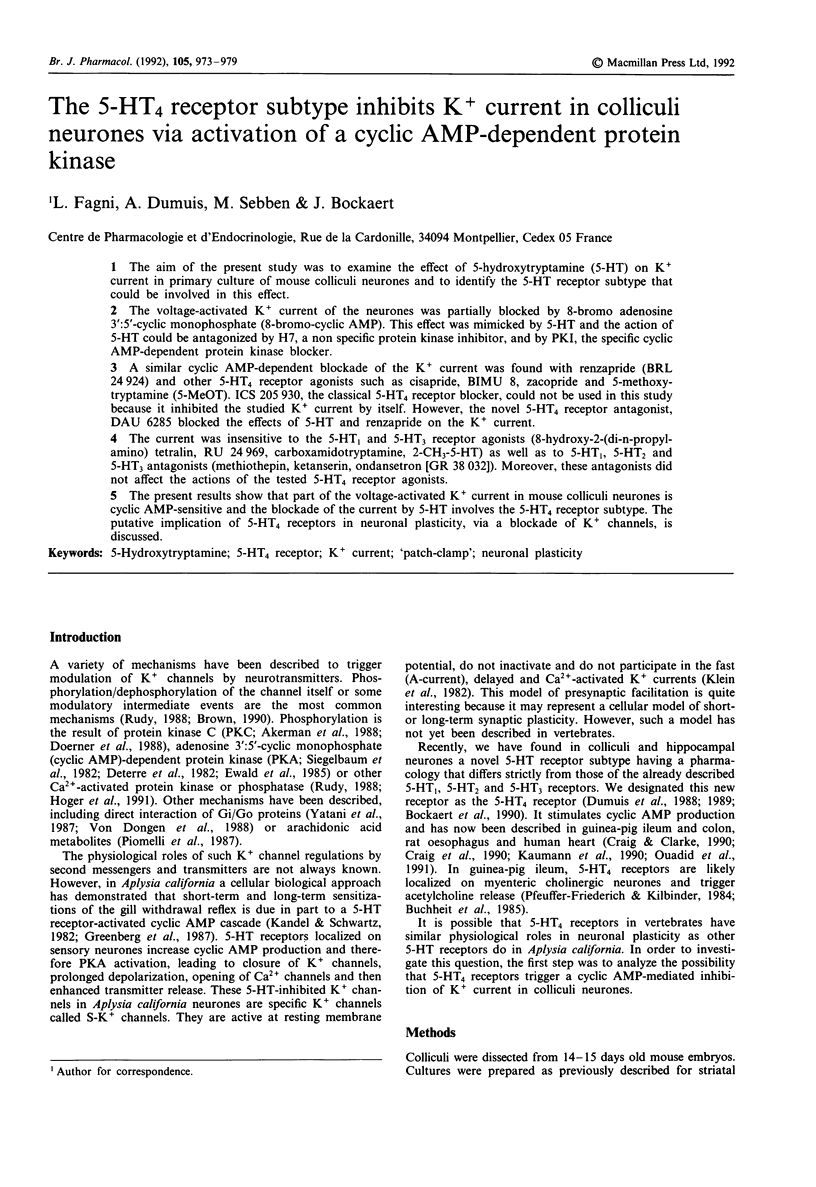
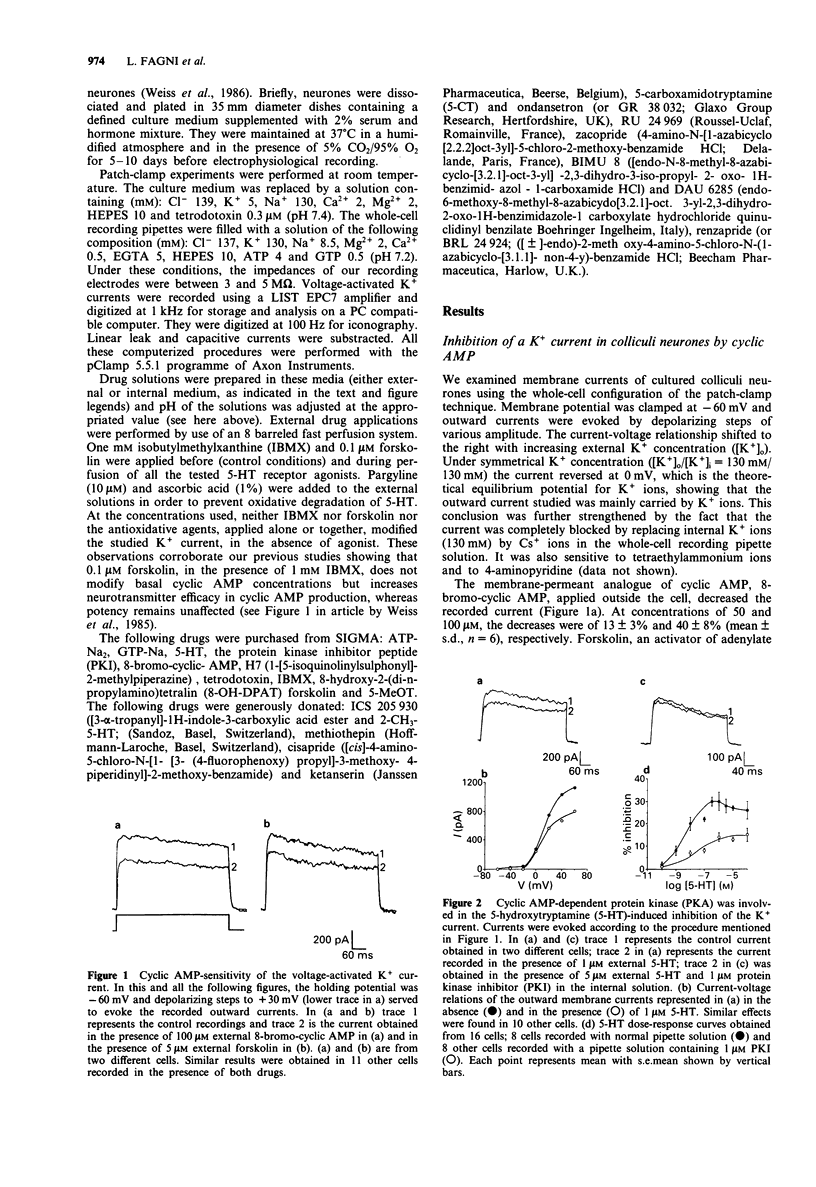

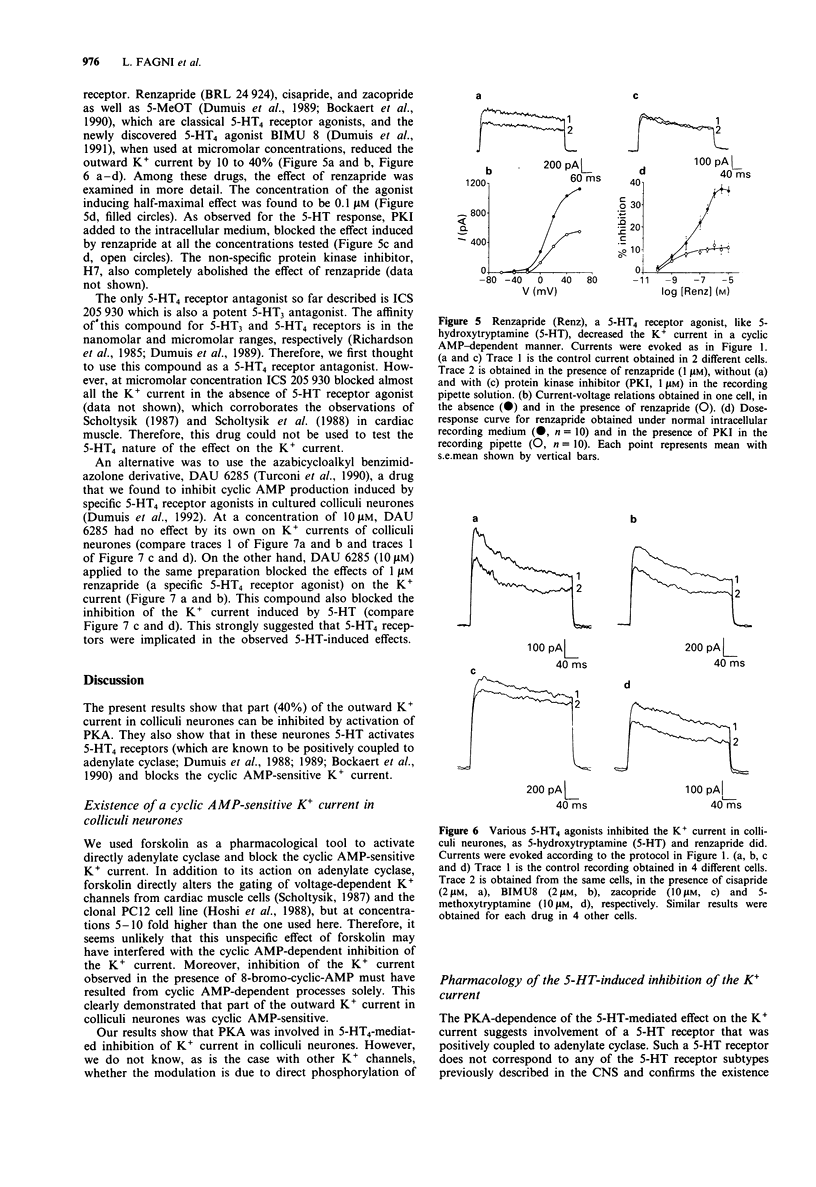
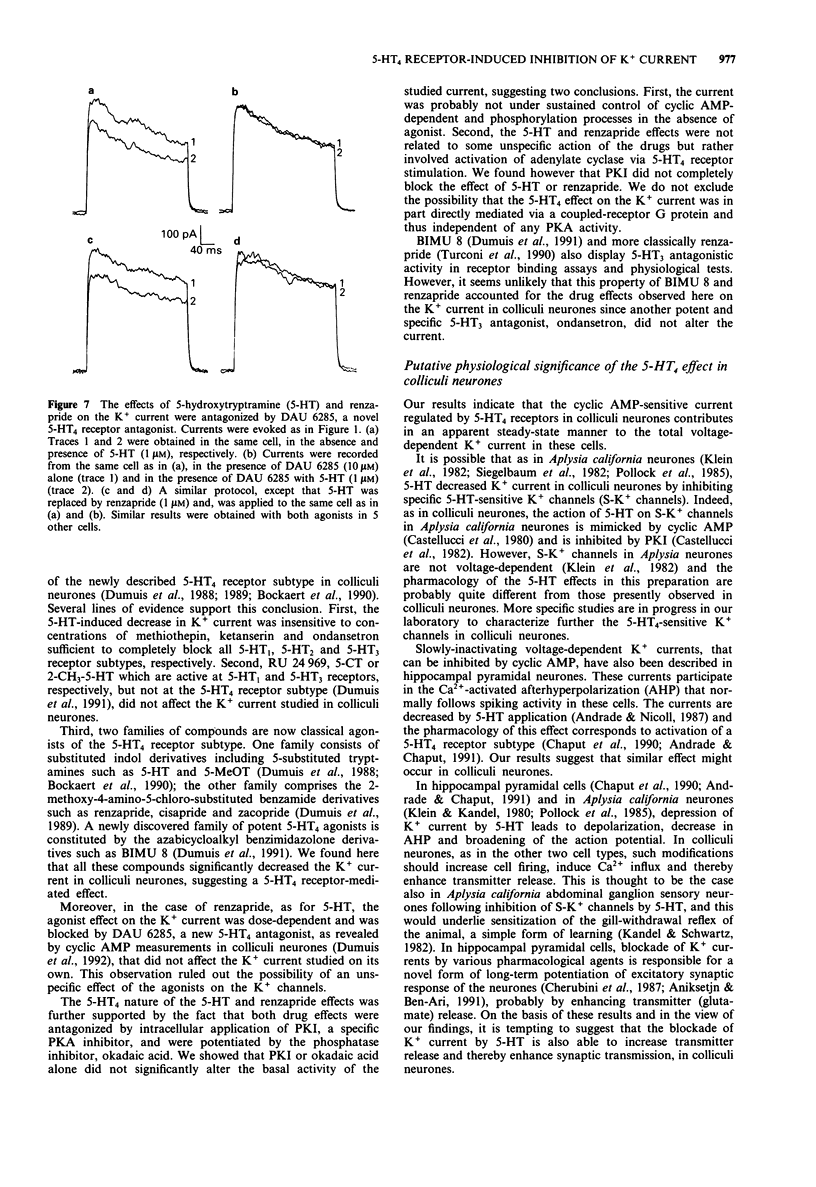
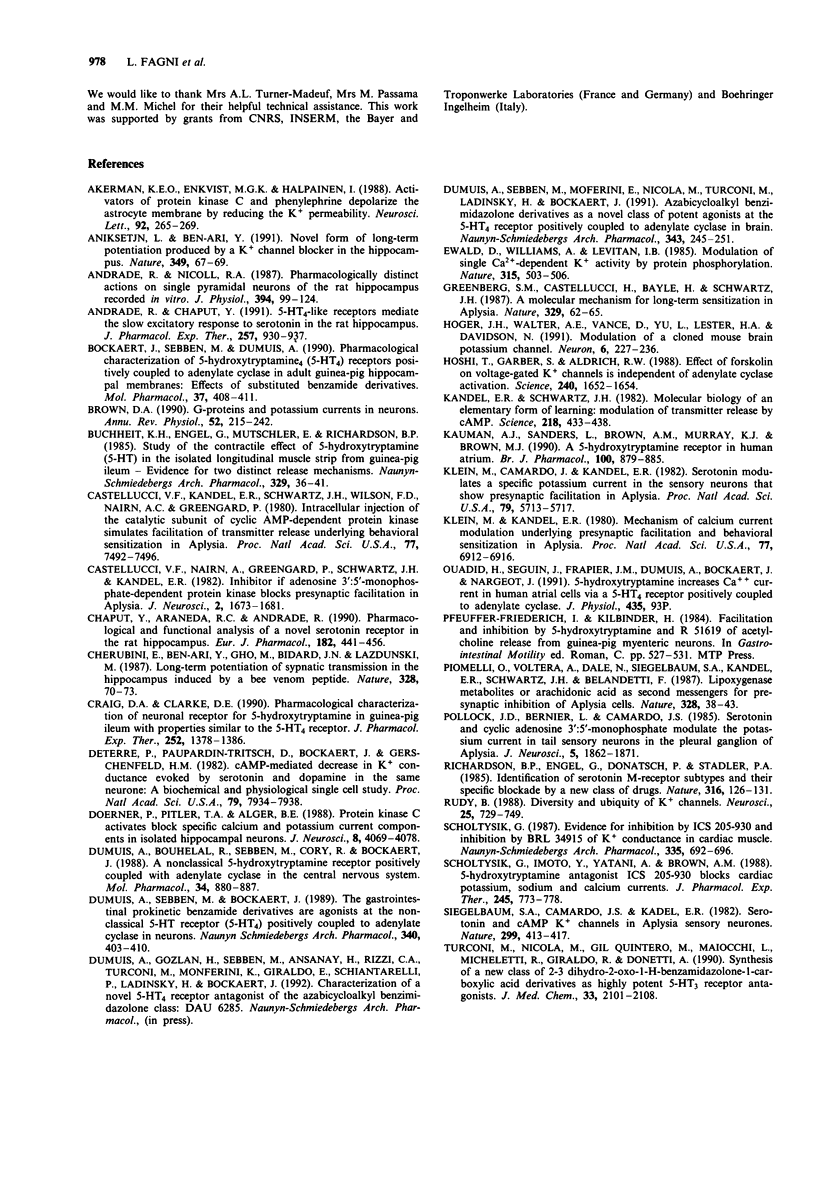

Selected References
These references are in PubMed. This may not be the complete list of references from this article.
- Akerman K. E., Enkvist M. O., Holopainen I. Activators of protein kinase C and phenylephrine depolarize the astrocyte membrane by reducing the K+ permeability. Neurosci Lett. 1988 Oct 17;92(3):265–269. doi: 10.1016/0304-3940(88)90600-3. [DOI] [PubMed] [Google Scholar]
- Andrade R., Chaput Y. 5-Hydroxytryptamine4-like receptors mediate the slow excitatory response to serotonin in the rat hippocampus. J Pharmacol Exp Ther. 1991 Jun;257(3):930–937. [PubMed] [Google Scholar]
- Andrade R., Nicoll R. A. Pharmacologically distinct actions of serotonin on single pyramidal neurones of the rat hippocampus recorded in vitro. J Physiol. 1987 Dec;394:99–124. doi: 10.1113/jphysiol.1987.sp016862. [DOI] [PMC free article] [PubMed] [Google Scholar]
- Aniksztejn L., Ben-Ari Y. Novel form of long-term potentiation produced by a K+ channel blocker in the hippocampus. Nature. 1991 Jan 3;349(6304):67–69. doi: 10.1038/349067a0. [DOI] [PubMed] [Google Scholar]
- Bockaert J., Sebben M., Dumuis A. Pharmacological characterization of 5-hydroxytryptamine4(5-HT4) receptors positively coupled to adenylate cyclase in adult guinea pig hippocampal membranes: effect of substituted benzamide derivatives. Mol Pharmacol. 1990 Mar;37(3):408–411. [PubMed] [Google Scholar]
- Brown D. A. G-proteins and potassium currents in neurons. Annu Rev Physiol. 1990;52:215–242. doi: 10.1146/annurev.ph.52.030190.001243. [DOI] [PubMed] [Google Scholar]
- Buchheit K. H., Engel G., Mutschler E., Richardson B. Study of the contractile effect of 5-hydroxytryptamine (5-HT) in the isolated longitudinal muscle strip from guinea-pig ileum. Evidence for two distinct release mechanisms. Naunyn Schmiedebergs Arch Pharmacol. 1985 Mar;329(1):36–41. doi: 10.1007/BF00695189. [DOI] [PubMed] [Google Scholar]
- Castellucci V. F., Kandel E. R., Schwartz J. H., Wilson F. D., Nairn A. C., Greengard P. Intracellular injection of t he catalytic subunit of cyclic AMP-dependent protein kinase simulates facilitation of transmitter release underlying behavioral sensitization in Aplysia. Proc Natl Acad Sci U S A. 1980 Dec;77(12):7492–7496. doi: 10.1073/pnas.77.12.7492. [DOI] [PMC free article] [PubMed] [Google Scholar]
- Castellucci V. F., Nairn A., Greengard P., Schwartz J. H., Kandel E. R. Inhibitor of adenosine 3':5'-monophosphate-dependent protein kinase blocks presynaptic facilitation in Aplysia. J Neurosci. 1982 Dec;2(12):1673–1681. doi: 10.1523/JNEUROSCI.02-12-01673.1982. [DOI] [PMC free article] [PubMed] [Google Scholar]
- Chaput Y., Araneda R. C., Andrade R. Pharmacological and functional analysis of a novel serotonin receptor in the rat hippocampus. Eur J Pharmacol. 1990 Jul 17;182(3):441–456. doi: 10.1016/0014-2999(90)90041-4. [DOI] [PubMed] [Google Scholar]
- Cherubini E., Ben Ari Y., Gho M., Bidard J. N., Lazdunski M. Long-term potentiation of synaptic transmission in the hippocampus induced by a bee venom peptide. Nature. 1987 Jul 2;328(6125):70–73. doi: 10.1038/328070a0. [DOI] [PubMed] [Google Scholar]
- Craig D. A., Clarke D. E. Pharmacological characterization of a neuronal receptor for 5-hydroxytryptamine in guinea pig ileum with properties similar to the 5-hydroxytryptamine receptor. J Pharmacol Exp Ther. 1990 Mar;252(3):1378–1386. [PubMed] [Google Scholar]
- Deterre P., Paupardin-Tritsch D., Bockaert J., Gerschenfeld H. M. cAMP-mediated decrease in K+ conductance evoked by serotonin and dopamine in the same neuron: a biochemical and physiological single-cell study. Proc Natl Acad Sci U S A. 1982 Dec;79(24):7934–7938. doi: 10.1073/pnas.79.24.7934. [DOI] [PMC free article] [PubMed] [Google Scholar]
- Doerner D., Pitler T. A., Alger B. E. Protein kinase C activators block specific calcium and potassium current components in isolated hippocampal neurons. J Neurosci. 1988 Nov;8(11):4069–4078. doi: 10.1523/JNEUROSCI.08-11-04069.1988. [DOI] [PMC free article] [PubMed] [Google Scholar]
- Dumuis A., Bouhelal R., Sebben M., Cory R., Bockaert J. A nonclassical 5-hydroxytryptamine receptor positively coupled with adenylate cyclase in the central nervous system. Mol Pharmacol. 1988 Dec;34(6):880–887. [PubMed] [Google Scholar]
- Dumuis A., Sebben M., Bockaert J. The gastrointestinal prokinetic benzamide derivatives are agonists at the non-classical 5-HT receptor (5-HT4) positively coupled to adenylate cyclase in neurons. Naunyn Schmiedebergs Arch Pharmacol. 1989 Oct;340(4):403–410. doi: 10.1007/BF00167041. [DOI] [PubMed] [Google Scholar]
- Dumuis A., Sebben M., Monferini E., Nicola M., Turconi M., Ladinsky H., Bockaert J. Azabicycloalkyl benzimidazolone derivatives as a novel class of potent agonists at the 5-HT4 receptor positively coupled to adenylate cyclase in brain. Naunyn Schmiedebergs Arch Pharmacol. 1991 Mar;343(3):245–251. doi: 10.1007/BF00251122. [DOI] [PubMed] [Google Scholar]
- Ewald D. A., Williams A., Levitan I. B. Modulation of single Ca2+-dependent K+-channel activity by protein phosphorylation. Nature. 1985 Jun 6;315(6019):503–506. doi: 10.1038/315503a0. [DOI] [PubMed] [Google Scholar]
- Greenberg S. M., Castellucci V. F., Bayley H., Schwartz J. H. A molecular mechanism for long-term sensitization in Aplysia. Nature. 1987 Sep 3;329(6134):62–65. doi: 10.1038/329062a0. [DOI] [PubMed] [Google Scholar]
- Hoger J. H., Walter A. E., Vance D., Yu L., Lester H. A., Davidson N. Modulation of a cloned mouse brain potassium channel. Neuron. 1991 Feb;6(2):227–236. doi: 10.1016/0896-6273(91)90358-7. [DOI] [PubMed] [Google Scholar]
- Hoshi T., Garber S. S., Aldrich R. W. Effect of forskolin on voltage-gated K+ channels is independent of adenylate cyclase activation. Science. 1988 Jun 17;240(4859):1652–1655. doi: 10.1126/science.2454506. [DOI] [PubMed] [Google Scholar]
- Kandel E. R., Schwartz J. H. Molecular biology of learning: modulation of transmitter release. Science. 1982 Oct 29;218(4571):433–443. doi: 10.1126/science.6289442. [DOI] [PubMed] [Google Scholar]
- Kaumann A. J., Sanders L., Brown A. M., Murray K. J., Brown M. J. A 5-hydroxytryptamine receptor in human atrium. Br J Pharmacol. 1990 Aug;100(4):879–885. doi: 10.1111/j.1476-5381.1990.tb14108.x. [DOI] [PMC free article] [PubMed] [Google Scholar]
- Klein M., Camardo J., Kandel E. R. Serotonin modulates a specific potassium current in the sensory neurons that show presynaptic facilitation in Aplysia. Proc Natl Acad Sci U S A. 1982 Sep;79(18):5713–5717. doi: 10.1073/pnas.79.18.5713. [DOI] [PMC free article] [PubMed] [Google Scholar]
- Klein M., Kandel E. R. Mechanism of calcium current modulation underlying presynaptic facilitation and behavioral sensitization in Aplysia. Proc Natl Acad Sci U S A. 1980 Nov;77(11):6912–6916. doi: 10.1073/pnas.77.11.6912. [DOI] [PMC free article] [PubMed] [Google Scholar]
- Piomelli D., Volterra A., Dale N., Siegelbaum S. A., Kandel E. R., Schwartz J. H., Belardetti F. Lipoxygenase metabolites of arachidonic acid as second messengers for presynaptic inhibition of Aplysia sensory cells. Nature. 1987 Jul 2;328(6125):38–43. doi: 10.1038/328038a0. [DOI] [PubMed] [Google Scholar]
- Pollock J. D., Bernier L., Camardo J. S. Serotonin and cyclic adenosine 3':5'-monophosphate modulate the potassium current in tail sensory neurons in the pleural ganglion of Aplysia. J Neurosci. 1985 Jul;5(7):1862–1871. doi: 10.1523/JNEUROSCI.05-07-01862.1985. [DOI] [PMC free article] [PubMed] [Google Scholar]
- Richardson B. P., Engel G., Donatsch P., Stadler P. A. Identification of serotonin M-receptor subtypes and their specific blockade by a new class of drugs. Nature. 1985 Jul 11;316(6024):126–131. doi: 10.1038/316126a0. [DOI] [PubMed] [Google Scholar]
- Rudy B. Diversity and ubiquity of K channels. Neuroscience. 1988 Jun;25(3):729–749. doi: 10.1016/0306-4522(88)90033-4. [DOI] [PubMed] [Google Scholar]
- Scholtysik G. Evidence for inhibition by ICS 205-930 and stimulation by BRL 34915 of K+ conductance in cardiac muscle. Naunyn Schmiedebergs Arch Pharmacol. 1987 Jun;335(6):692–696. doi: 10.1007/BF00166988. [DOI] [PubMed] [Google Scholar]
- Scholtysik G., Imoto Y., Yatani A., Brown A. M. 5-Hydroxytryptamine antagonist ICS 205-930 blocks cardiac potassium, sodium and calcium currents. J Pharmacol Exp Ther. 1988 Jun;245(3):773–778. [PubMed] [Google Scholar]
- Siegelbaum S. A., Camardo J. S., Kandel E. R. Serotonin and cyclic AMP close single K+ channels in Aplysia sensory neurones. Nature. 1982 Sep 30;299(5882):413–417. doi: 10.1038/299413a0. [DOI] [PubMed] [Google Scholar]
- Turconi M., Nicola M., Quintero M. G., Maiocchi L., Micheletti R., Giraldo E., Donetti A. Synthesis of a new class of 2,3-dihydro-2-oxo-1H-benzimidazole-1-carboxylic acid derivatives as highly potent 5-HT3 receptor antagonists. J Med Chem. 1990 Aug;33(8):2101–2108. doi: 10.1021/jm00170a009. [DOI] [PubMed] [Google Scholar]
- VanDongen A. M., Codina J., Olate J., Mattera R., Joho R., Birnbaumer L., Brown A. M. Newly identified brain potassium channels gated by the guanine nucleotide binding protein Go. Science. 1988 Dec 9;242(4884):1433–1437. doi: 10.1126/science.3144040. [DOI] [PubMed] [Google Scholar]
- Weiss S., Pin J. P., Sebben M., Kemp D. E., Sladeczek F., Gabrion J., Bockaert J. Synaptogenesis of cultured striatal neurons in serum-free medium: a morphological and biochemical study. Proc Natl Acad Sci U S A. 1986 Apr;83(7):2238–2242. doi: 10.1073/pnas.83.7.2238. [DOI] [PMC free article] [PubMed] [Google Scholar]
- Weiss S., Sebben M., Garcia-Sainz J. A., Bockaert J. D2-dopamine receptor-mediated inhibition of cyclic AMP formation in striatal neurons in primary culture. Mol Pharmacol. 1985 Jun;27(6):595–599. [PubMed] [Google Scholar]
- Yatani A., Codina J., Brown A. M., Birnbaumer L. Direct activation of mammalian atrial muscarinic potassium channels by GTP regulatory protein Gk. Science. 1987 Jan 9;235(4785):207–211. doi: 10.1126/science.2432660. [DOI] [PubMed] [Google Scholar]


